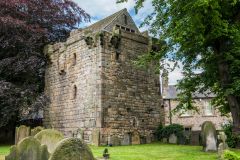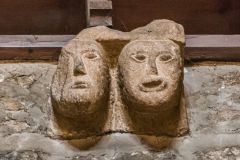
The church of St Andrew in Corbridge has a history stretching back into the Dark Ages. In the 7th century, the Corbridge area was part of a royal estate. Around AD 674 St Wilfrid sent his followers to Corbridge to establish a church, or monastery. No trace of that 7th-century building remains (it was probably built of timber) but the present medieval building still retains traces of a later 8th-century church founded around AD 786.
It also has much older stonework, brought here from the nearby Roman fort of Corstopitum. The most obvious Roman remain is the high and narrow tower arch, brought here in its entirety from the Roman fort. It is thought to date to around AD 150.
Corbridge was raided by the Danes in AD 875, and was later the site of battles between Scots, Danes, and Northumbrians in 914 and again in 918. The destruction was so terrible that only the church was left standing.

In the early 12th century Henry I gave the church to his chaplain, Richard d'Orival, who was probably responsible for rebuilding the earlier Saxon building and inserting the present Norman doorway. Around the doorway the stones are stained pink, said to be the result of fire when the church - and much of the town - was set ablaze during a raid by William Wallace in 1296.
At the west end of the church is a Saxon window, and you can still see the original Saxon entrance in the west wall of the tower. Entry to the church is through a 12-century Norman doorway decorated with traditional Norman zig-zag moulding. Over the porch is n 11th-century belfry tower.
The chancel dates to the 13th century. Like the nave aisles and the transepts, it was built using stones from Corstopitum. The chancel arch dividing the nave and chancel is also 13th century, in Early English style.
In the north transept are several old memorial stones, but the most interesting carved stone is found under the first window on the left-hand side. Here you can see a carving of a pair of shears, indicating the burial place of a woman.

At the north end of the transept is a 13th century carved grave slab set under a niche. The inscription reads 'Hic jacet in terris Aslini filius Hugo', which translates as 'Here in the earth lies Hugo son of Aslin'.
In the south transept are several carved stone fragments, including an inscribed stone carved with part of a phrase translating as 'Here lies Eric'.
In the churchyard is the Vicar's Pele, a fortified tower built in the 14th century to protect the church and the vicar against Scottish raiders. Like the church itself, the Vicar's Pele is built using stones from Corbridge Roman fort. It stands three storeys high, with an internal staircase between floors. During Scottish raids, cattle could be brought into the ground floor chamber. The middle floor was then used as living quarters and the top floor for defence.
Beside the Vicar's Pele is the medieval market cross, set in a base made from a Roman altar stone. Outside the west end of the churchyard is The King's Oven, a communal bread oven dating to the early 14th century.
St Andrew's exudes a sense of history, and is well worth seeking out. The church was open when we visited.
About Corbridge, St Andrew's Church
Address: Middle Street,
Corbridge,
Northumberland,
England, NE45 5NH
Attraction Type: Historic Church
Location: On the north side of the market place, at the west end of Middle Street. Limited parking on the market place.
Website: Corbridge, St Andrew's Church
Location
map
OS: NY988643
Photo Credit: David Ross and Britain Express
HERITAGE
 We've 'tagged' this attraction information to help you find related historic attractions and learn more about major time periods mentioned.
We've 'tagged' this attraction information to help you find related historic attractions and learn more about major time periods mentioned.
Find other attractions tagged with:
NEARBY HISTORIC ATTRACTIONS
Heritage Rated from 1- 5 (low to exceptional) on historic interest
Corbridge Bridge - 0.1 miles (Historic Building) ![]()
Corbridge Roman Town - 0.7 miles (Roman Site) ![]()
Aydon Castle - 1.7 miles (Castle) ![]()
Northumberland National Park - 3.2 miles (Countryside) ![]()
Hexham Abbey - 3.3 miles (Historic Church) ![]()
Bywell Hall - 4 miles (Historic House) ![]()
Bywell, St Andrew's Church - 4.1 miles (Historic Church) ![]()
Bywell, St Peter's Church - 4.2 miles (Historic Church) ![]()
Nearest Holiday Cottages to Corbridge, St Andrew's Church:
More self catering near Corbridge, St Andrew's Church











